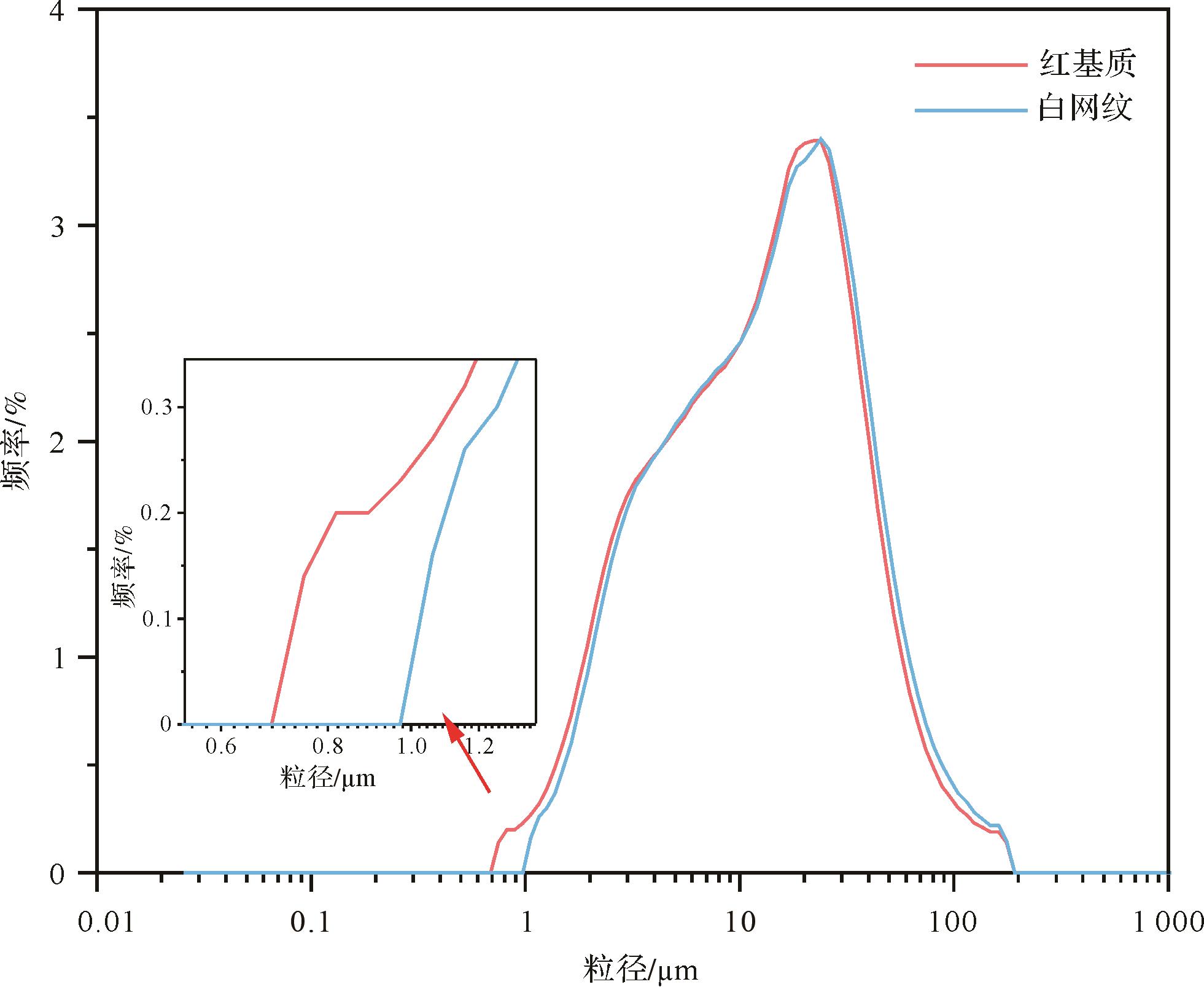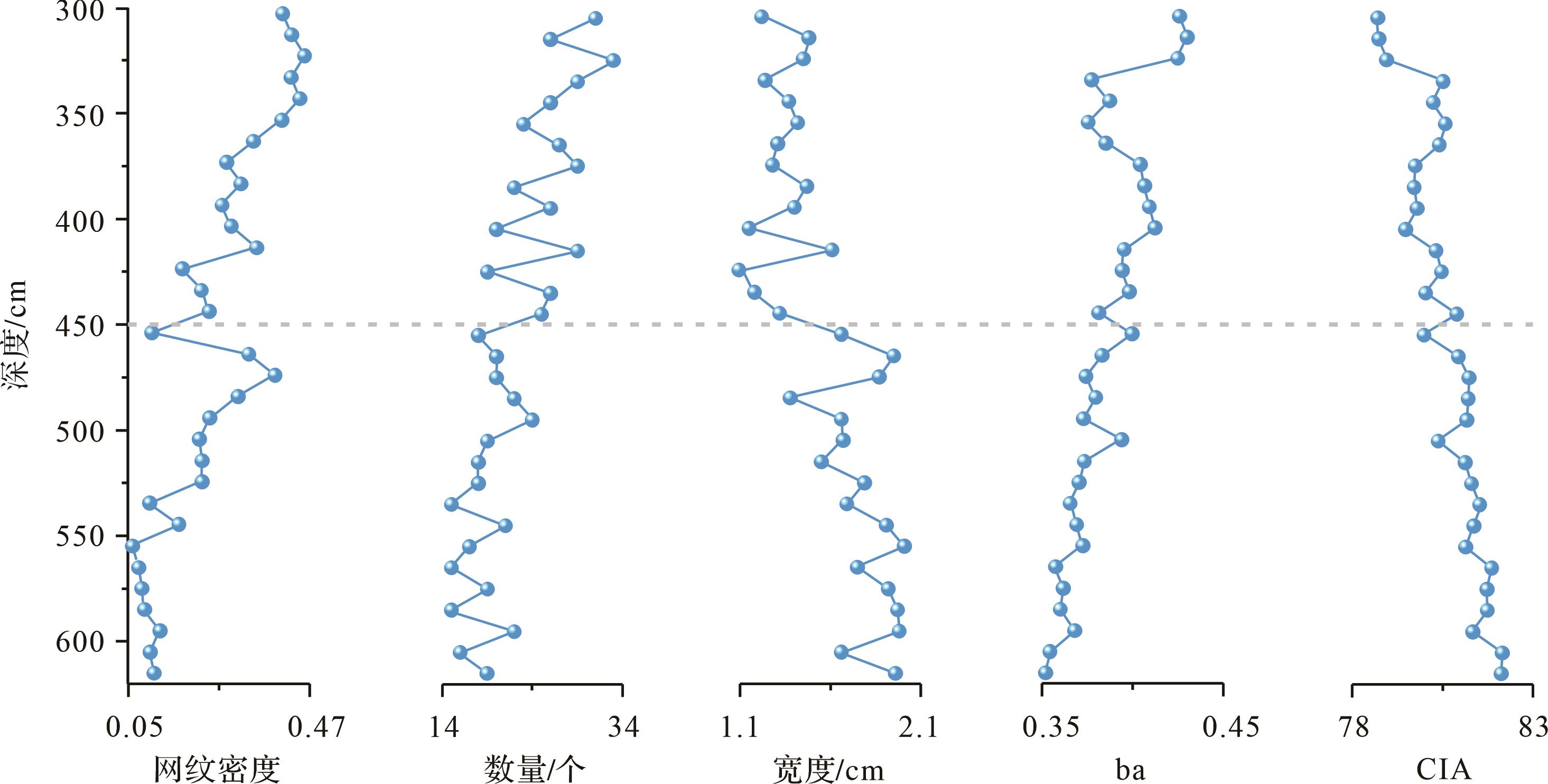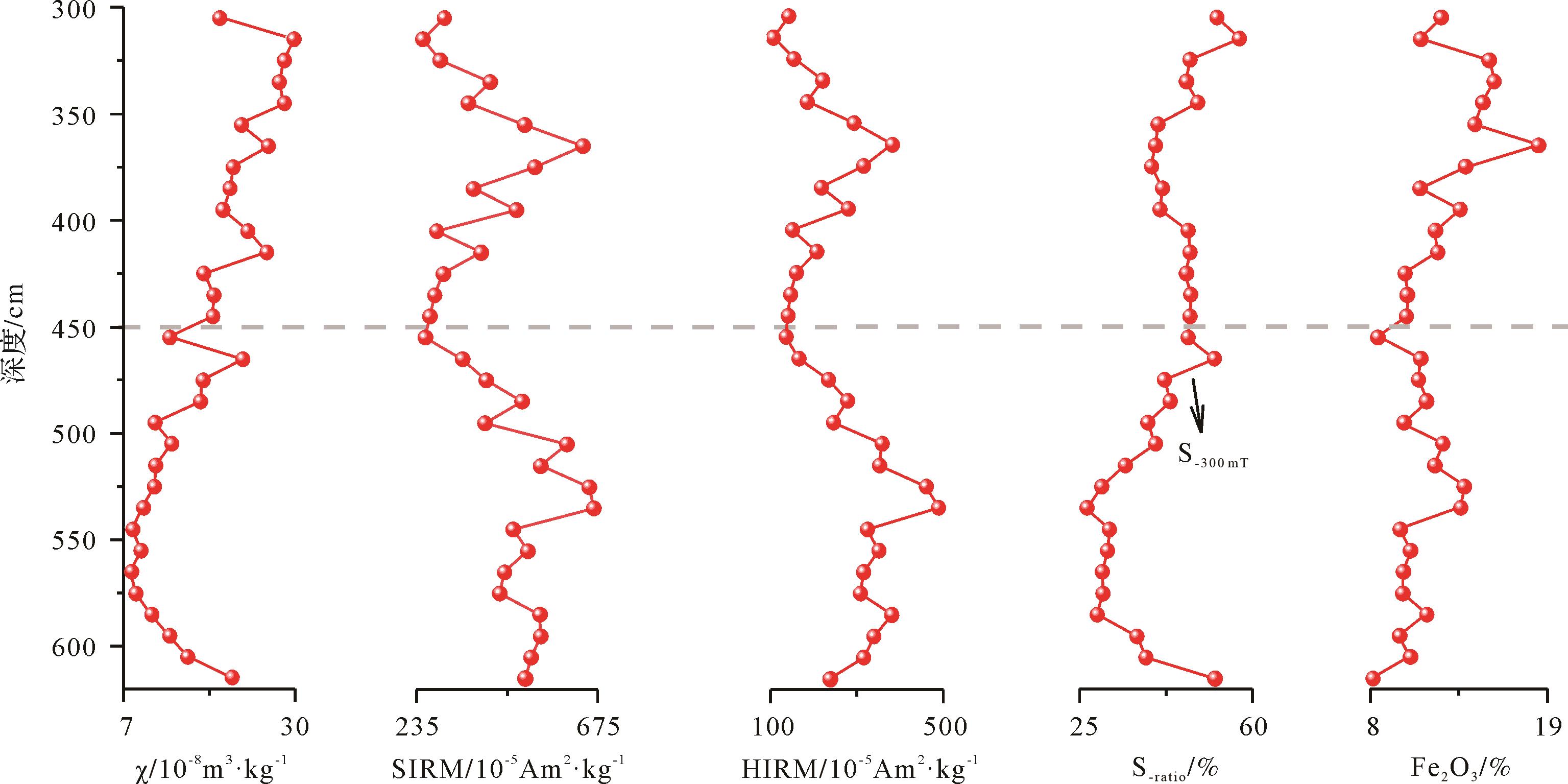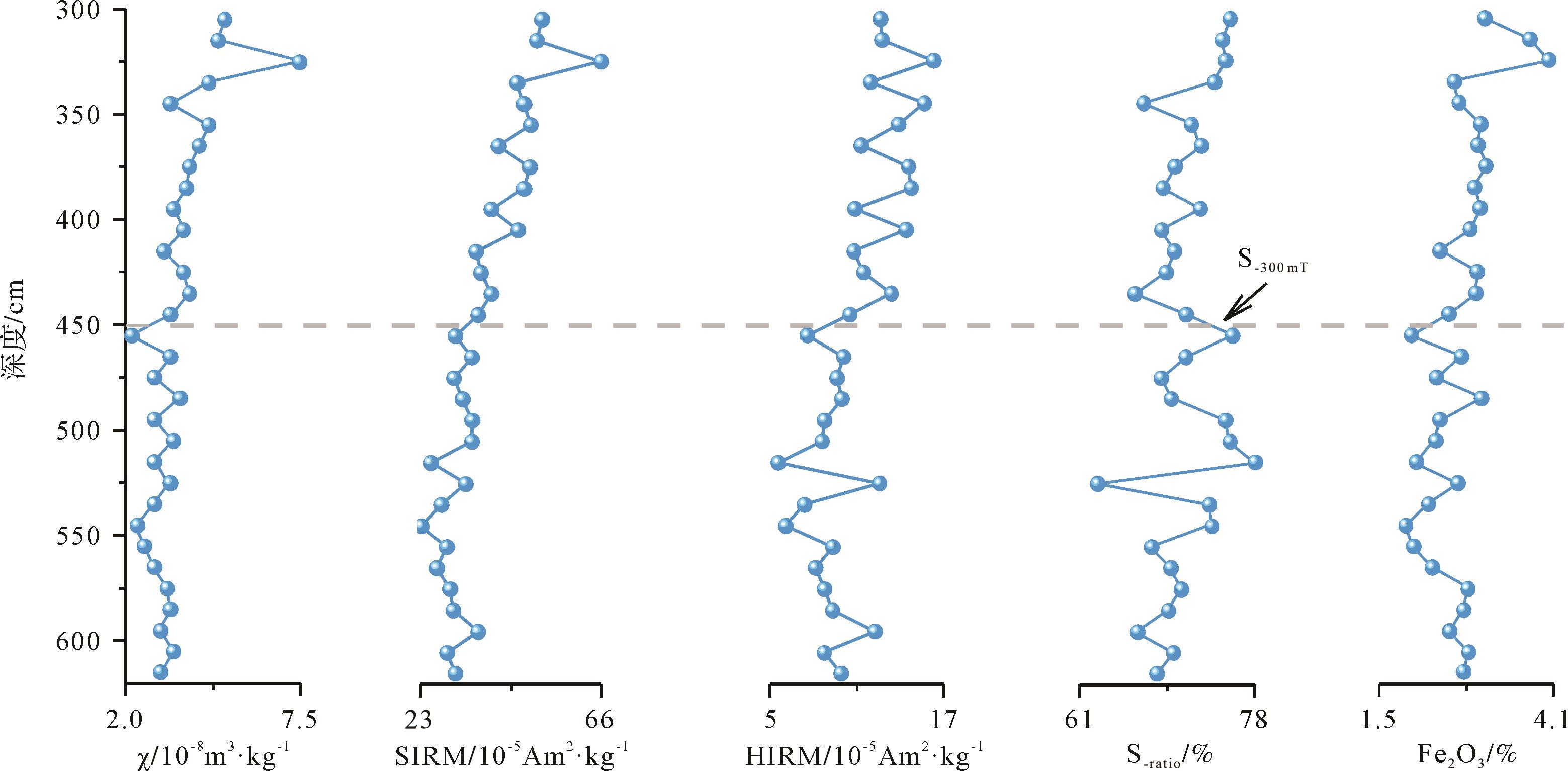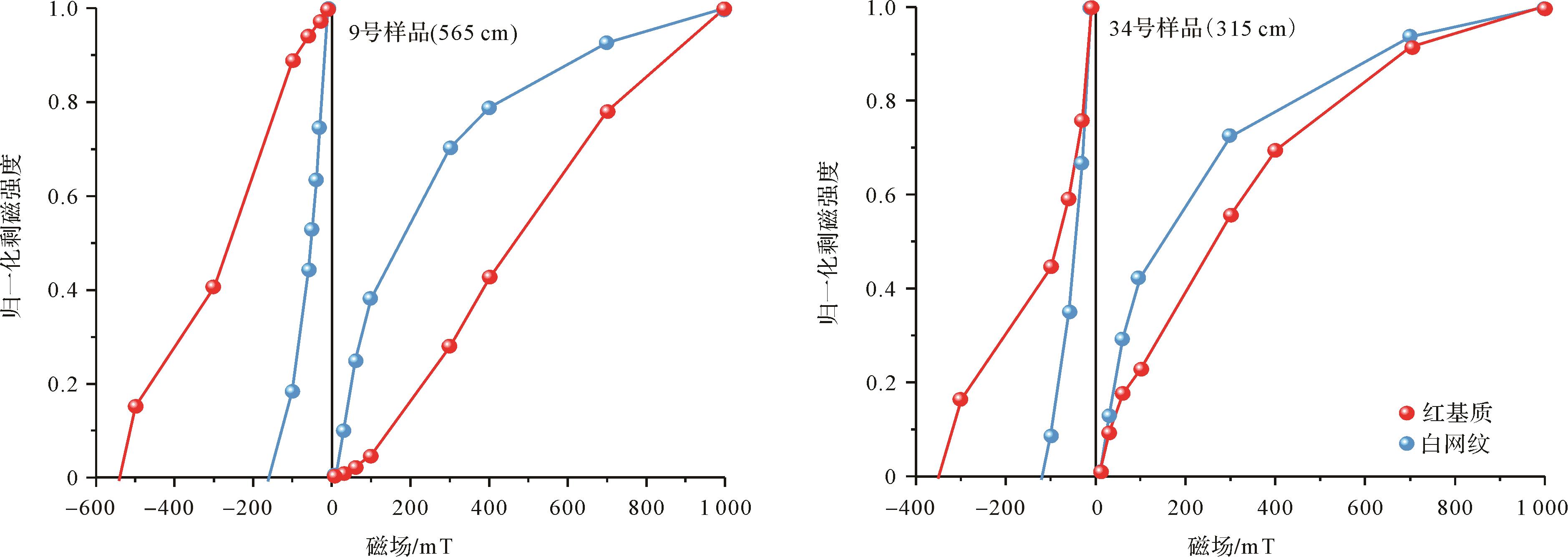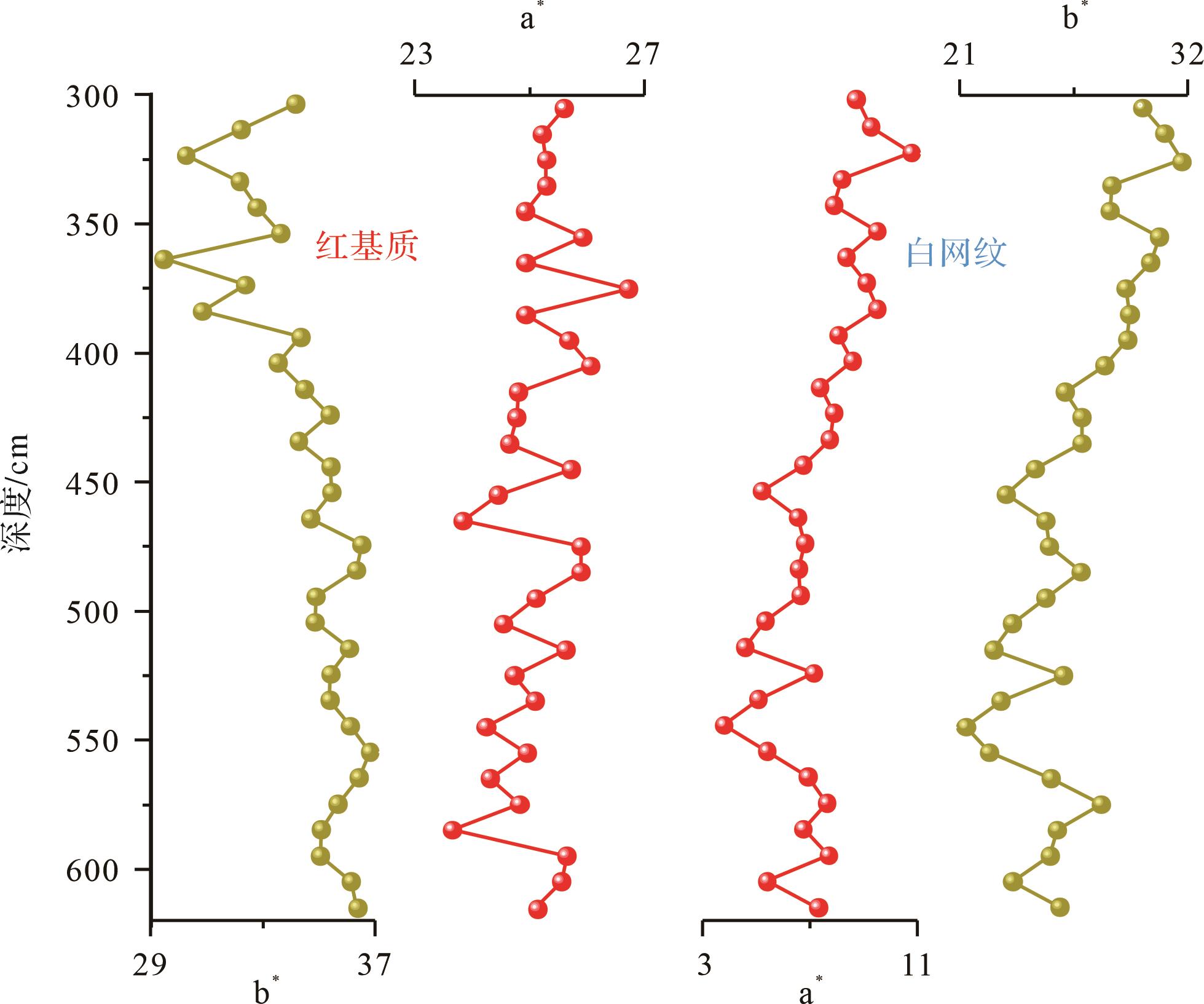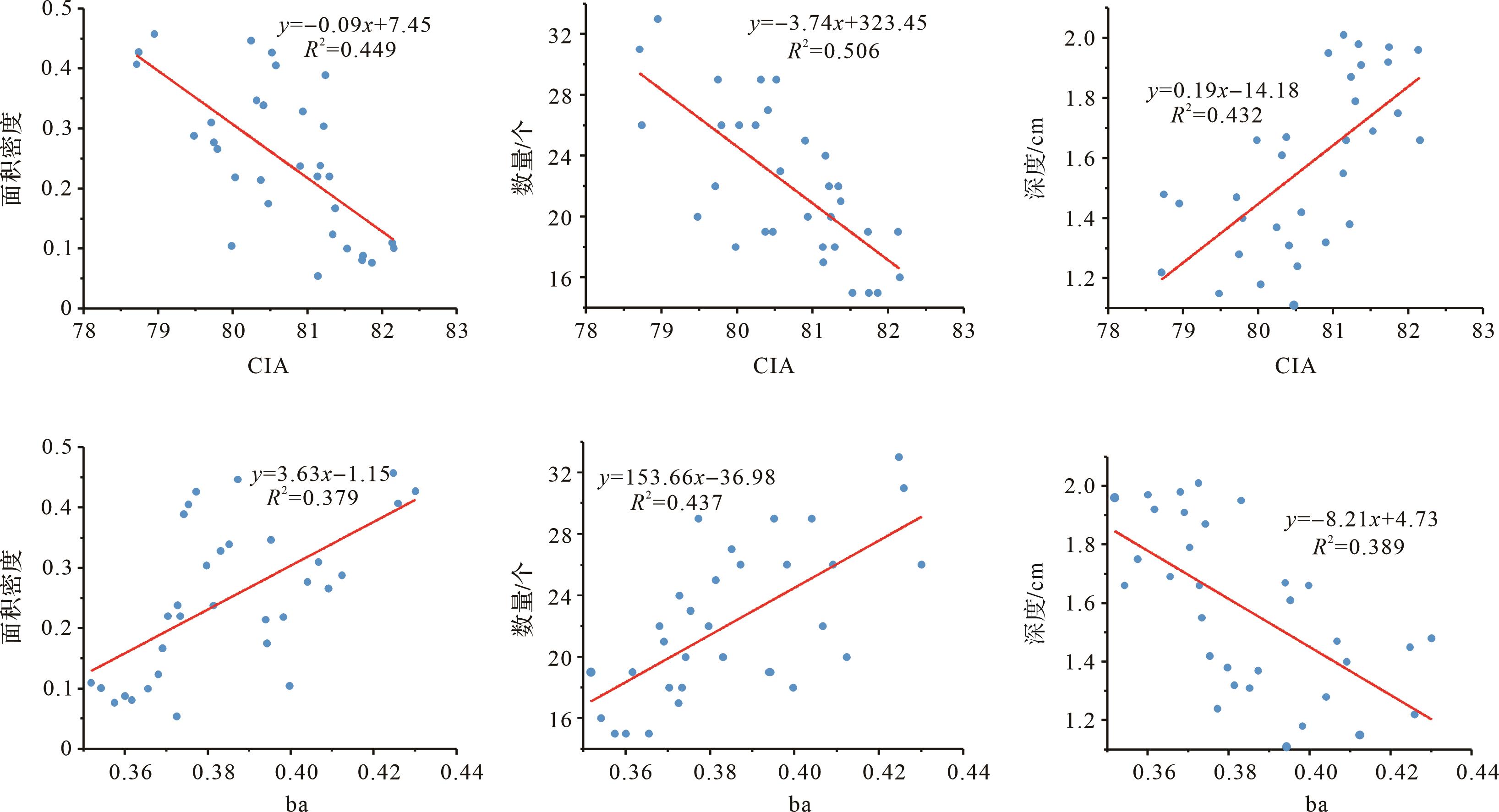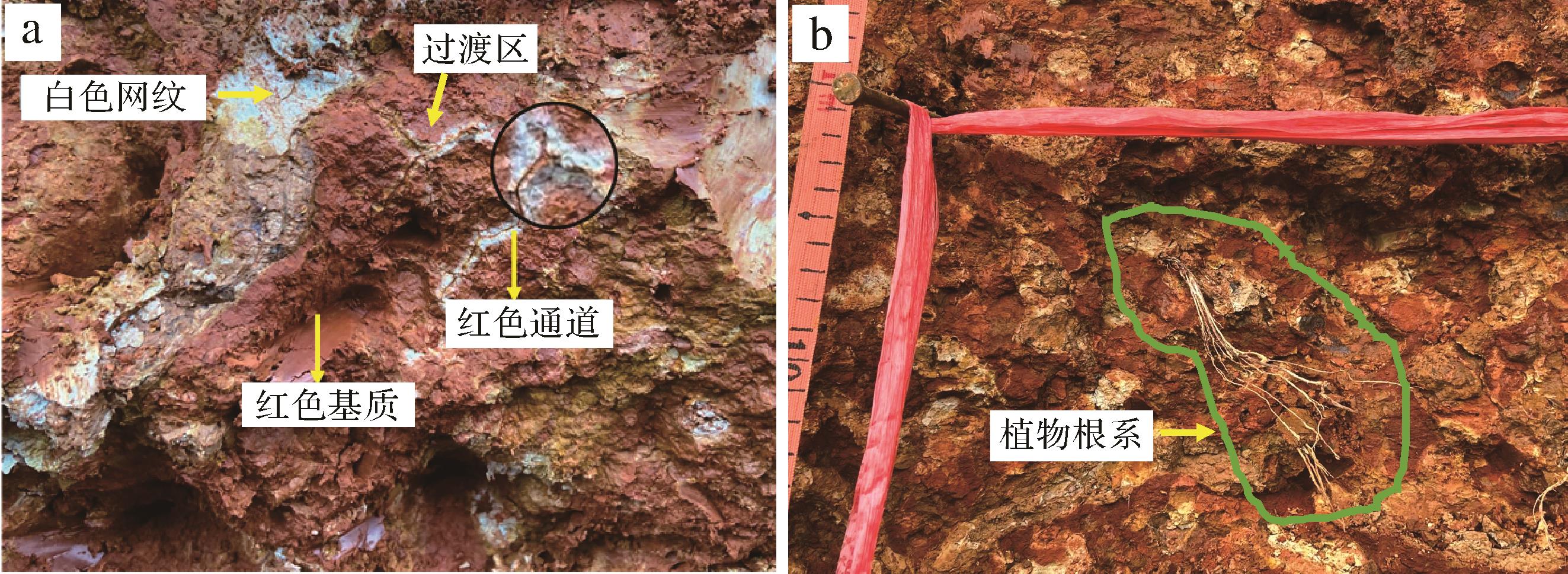HTML
-
加积型网纹红土在长江中下游地区分布较为广泛,其形成、发育和分布与季风的建立、发展等有关,是我国南方环境对全球性重大地质—环境变化的响应[1],蕴含了较为丰富的第四纪气候与环境变化的信息[2⁃5]。网纹红土剖面的顶部为棕黄色土层,上部为均质红土层,中—下部为网纹层,底部为砂砾石层,部分剖面缺失棕黄色土层或均质红土层。网纹层中的网纹犹如一枚硬币,其一方面表现为理化性质,另一方面表现为几何形态,两者从不同角度反映了网纹特征。以往研究多关注网纹红土的理化性质,如利用磁学方法揭示地层中磁性矿物的类型、磁学特征及气候意义[2⁃8];色度指标的变化特征及环境意义[9⁃12];采用地球化学手段阐明红基质和白网纹的元素分异特征,以及网纹红土的风化特征[13⁃18]等。近年来,作为网纹红土醒目标志的网纹形态引起了较多关注[19⁃24]。有研究发现网纹发育的强弱与气候变化可能存在对应关系,与世界其他地区相比我国的网纹可能指示了极其温暖潮湿的成土期[15]。然而,也有研究认为网纹可能与浅层地下水位变动有关[25],而非指示古气候的变化[12]。总而言之,目前对网纹形态的定量化分析较为少见,且其环境意义还有待验证和进一步探讨。为此,本文以九江加积型网纹红土的网纹作为研究对象,在对网纹形态进行定量表征与分析的基础上,将形态特征与磁学分析、地球化学及色度等指标相结合,进一步验证和探析网纹形态的环境意义。
-
研究剖面(29°42′12″ N,116°01′57″ E)位于江西省九江市濂溪区五里街道,地处九江东部地区。采样剖面是庐山余脉的低矮丘陵,因乡间公路开挖露出,海拔50 m,剖面厚约6.2 m(图1)。其中,0~50 cm为现代土壤层,质地松软,植物根系发育,颜色偏暗棕色;50~150 cm为黄棕色土层,可见植物根系;150 cm开始出现铁锰胶膜,其下网纹多密集细小,形态多呈蠕虫状、点状,420~600 cm为棕红色网纹红土层,夹杂圆点状网纹,600 cm以下为暗红色网纹红土层,网纹较稀疏,呈条带状,有植物根系和地下水渗出。
-
根据研究目的和网纹分布特点,在该剖面选择纵深3~6.2 m、横长50 cm处布置采样区,纵向上再以50 cm为间隔拉红绳,共得7个样方,在清理每个样方表面的残留土渣后,利用数码相机按样方进行拍照,所得数码照片用来对白网纹进行数字化提取。此后,自下而上以10 cm为间隔进行采样,共采集32个样品。将样品置于40 ℃恒温烘箱内烘干后,按红基质和白网纹对其进行分离,共获取红基质、白网纹样品各32个。然后,将红白分离后的样品研磨均匀,分别称取5 g,进行磁学参数测量;并将上述各样品研磨压片,用PHLIPS公司生产的PW2 440型X射线荧光光谱仪测量主量元素,分析误差小于2%,常用风化指标CIA和ba均按分子比计算,CIA=Al2O3/(Al2O3+CaO+Na2O+K2O)×100,其中CaO指硅酸盐矿物中的摩尔含量,本文采用Mclennan的方法[26]矫正其含量;ba=(K2O+CaO+Na2O+MgO)/Al2O3;色度测试仪器为柯尼卡美能达CR-400色彩色差仪,选用 CIELAB 表色系统,测量指标为a*(红度)、b*(黄度),在测试前先将样品用研磨钵研磨,并过200目筛,处理后样品作为测试样;粒度测试仪器为英国Malvern仪器有限公司生产的Mastersizer2000型激光粒度粒形仪,测量量程为0.02~2 000 μm,重复测量误差小于2%。整个前处理和磁学、地球化学、色度及粒度实验均在浙江师范大学地理过程实验室完成。
将所拍摄7个样方的数码照片分别等分为5份,切割形成10 cm×50 cm大小,自上而下共得32张图像。利用ENVI 5.3监督分类功能对所获得的数码图像进行红基质与白网纹的分类(分类可行性分析均大于1.999),分别提取了32张白色网纹图像。在此基础上,利用Arcgis 10.2及Photoshop 2019分别计算了白网纹数量、白网纹大小(网纹面积密度及平均宽度)等有关的形态指标。其中,白网纹的数量表示样方内白色网纹的总个数;网纹面积密度为单位样方内白网纹面积占总面积比;网纹宽度则表示为白色网纹发育宽度的平均值。
1.1. 研究区概况
1.2. 样品采集与测试
-
典型加积型红土具有边沉积边风化的特点,是反演南方地区第四纪环境演变的良好载体,其广泛分布于长江以南28°~31° N区域[27-29]。
沉积物粒度特征可以反映物质在沉积过程中搬运动力的大小和特点,可用于判别沉积环境[28]。如表1的粒度测试结果所示,红基质和白网纹黏粒(<5 μm)及粉砂(5~50 μm)为优势粒级;砂(>50 μm)含量占比最小。其中10~50 μm粒级组分常被认为是“风尘基本粒组”[30],为占比最大的粒级,与北方午城黄土、古土壤具有很好的可比性。此外,红基质和白网纹的粒度频率曲线(图2)表现为双峰,第一众数粒级在粉砂,第二众数粒级分布在黏粒中,与前人研究结果相一致[28],也反映网纹红土粒度组成具有风成特性。其他学者通过多种手段(粒度、地球化学、植物硅酸体、重矿物及锆石等)在九江地区多个剖面测试结果均表明,该区域网纹红土为典型的加积型红土,主要为风尘沉积,物质来源具有多重性,远源组分可能来自北方黄土,近源则由长江、赣江、鄱阳湖区裸露的河湖沉积物提供[28,31⁃34]。
Table 1. Granularity composition of reticulate red earth in Jiujiang (%)
-
网纹数量主要是指网纹红土样方内白网纹的总数目,本次研究剖面网纹数量的计算结果如图3所示。可以看出,白网纹的数量总体上介于15~33,剖面上部(450 cm以上)的白网纹数量相对较多,而剖面下部(450 cm以下)的白网纹数量则相对较少,即自上而下大致呈现出由相对密集到较为稀疏的变化趋势。白网纹宽度是对网纹发育大小的一个表征,其数值主要介于1.15~2.08 cm。如图3所示,由剖面上部至下部,白网纹的宽度大体上呈波动增大的趋势,即本研究剖面上部(450 cm以上)的白色网纹相对细小,而剖面下部(450 cm以下)的白网纹相对宽大。本剖面白网纹的面积密度大体呈上大下小的波动变化特征。根据上述网纹形态在该研究剖面上的分布特征,可将其分为上下两段,其中上段网纹个数相对较多,但发育宽度较小;下段则与之不同,网纹数量相对较少,但发育宽度一般较大。
-
红基质和白网纹的元素地球化学分析结果如表2所示。根据网纹形态的分布情况,以450 cm为界将剖面分为上、下两层,红基质上、下层难溶组分(SiO2、Al2O3、Fe2O3)质量分数之和的平均值分别为82.83%、83.2%;易淋溶组分(K2O、CaO、Na2O、MgO)质量分数之和的平均值分别为2.74%、2.56%。白网纹上下层的难溶组分质量分数之和均值分别为88.49%、93.06%;易淋溶组分质量分数之和均值分别为3.65%、4.22%。二者的易溶组分元素相对于UCC值均属于流失型,极低的含量表明网纹红土成土期的气候较为湿热。TiO2相对富集,红基质与白网纹相差不大。
样品(数量) SiO2 Fe2O3 Al2O3 K2O Na2O CaO MgO TiO2 红基质(305~455 cm,n=15) 平均值 57.26 13.08 12.87 1.08 0.88 0.20 0.58 1.03 最小值 49.39 10.16 11.78 0.99 0.75 0.17 0.48 0.89 最大值 64.18 18.45 14.21 1.17 0.98 0.22 0.65 1.11 红基质(455~615 cm,n=17) 平均值 59.01 10.86 12.96 1.17 0.9 0.21 0.29 1.02 最小值 54.89 8.11 11.80 1.06 0.83 0.19 0.24 0.98 最大值 62.62 13.84 14.38 1.43 0.97 0.22 0.33 1.08 白网纹(305~455 cm,n=15) 平均值 70.62 2.99 14.88 1.34 1.15 0.29 0.88 1.16 最小值 60.31 2.40 12.25 1.06 0.91 0.24 0.65 0.92 最大值 75.15 4.03 17.68 1.61 1.26 0.33 1.06 1.28 白网纹(455~615 cm,n=17) 平均值 71.67 2.45 18.94 1.62 1.26 0.29 1.06 1.21 最小值 66.67 1.89 16.08 1.40 1.23 0.24 0.95 1.15 最大值 76.64 3.02 21.42 1.86 1.28 0.33 1.16 1.26 UCC[35] 71.67 2.45 18.94 1.62 1.26 0.29 1.06 1.21 Table 2. Composition of major elements of reticulate red earth in Jiujiang section (%)
不论上、下层,红基质Fe2O3的平均含量均显著高于白网纹,二者存在显著差异,进一步证实白网纹的形成与铁元素的迁移、重分布具有直接关系。此外,白网纹下层Fe2O3含量低于上层,与白网纹的上、下层不同的形态大小也具有一定的对应性。化学蚀变指数CIA可用于计算陆壳各类物质的风化程度,值越大指示风化越强[35-36]。风化淋溶指数ba反映沉积物中盐基离子的淋失程度,值越小代表风化越强[37]。白网纹CIA和ba均介于78~83和0.3~0.45,属于中度化学风化,且自剖面下部到上部有所减弱(图3),说明该剖面经历了由暖湿逐渐向冷干的转变,这与前人研究成果[34,38⁃41]较为一致。
-
由剖面的上部至下部,红基质的χ主要表现为逐渐降低的趋势,SIRM则总体上呈现出波动增加的趋势;而白网纹的χ和SIRM均低于红基质,两者自剖面上部向下总体上均表现出逐渐降低的趋势;红基质HIRM的变化趋势和SIRM的特征基本相似,而白网纹的HIRM则自上而下逐渐降低。上述结果表明,红基质中的反铁磁性矿物整体上随着深度增加而增大,而白网纹的反铁磁性矿物含量呈逐渐降低态势。已有较多成果发现网纹红土中反铁磁性矿物主要为赤铁矿和针铁矿[6,42⁃43],结合上述研究可能说明本剖面白网纹赤铁矿或针铁矿的含量存在剖面上的分布差异。此外,剖面中红基质和白网纹的S-ratio(S-300 mT)皆表现出与HIRM值相反的趋势(图4,5)。有学者指出,S-ratio值中间阶段的波动性可能是气候冷暖旋回的结果,而自下而上整体呈现增加的趋势则可能指示了区域早更新世晚期以来古气候波动性逐渐减弱,气候趋于稳定[42]。
等温剩磁(IRM)和反方向磁场退磁在常温下可以用于区分样品中“软”、“硬”磁组分[44⁃45]。选取深度为315 cm和565 cm的红基质和白网纹,测得最大强度为1 T的连续可变强磁场下4个样品的等温剩磁获得曲线。如图6所示,红基质、白网纹SIRM获得曲线在外场为0.3 T时均未达到90%以上饱和,说明赤铁矿、针铁矿等高矫顽力磁性矿物为网纹红土的主要磁性矿物。该结论也得到了剩磁矫顽力数据的支持。
剩磁矫顽力(Bcr)是使获得SIRM的样品剩磁降低到0所需的反向磁场,可用于了解样品“软”、“硬”剩磁组分含量信息[5]。如图6所示,白网纹的剩磁矫顽力相对较低(100~200 mT),红基质的剩磁矫顽力大于白网纹,超过300 mT。但二者矫顽力还是明显高于典型低矫顽力黄土样品[46],说明网纹红土含有赤铁矿、针铁矿等高矫顽力的硬磁性矿物。综上,网纹层的红基质、白网纹以反铁磁性矿物为主,前者含量随着深度下降而增加,后者随深度下降而减少。
-
颜色是土壤重要的且容易量测的指标,可用来反映矿物组成情况。红度(a*)值介于-60(绿)至+60(红),1.7%的赤铁矿即可使土壤呈红色,故常被用作赤铁矿含量的粗略代用指标;黄度(b*)值介于-60(蓝)至+60(黄),棕黄色针铁矿含量对黄度值具有较大影响,b*随前者含量的增多而增大[47]。红基质和白网纹的红度(a*)具有较大的差异,红基质的a*介于23.56~26.73,平均值为25.13,而白网纹的a*介于3.81~10.8,平均值为7.28(图7)。由此可见前者的红度明显高于后者的红度,这与二者醒目的颜色差异较为吻合。网纹红土的红度与赤铁矿含量具有较好的线性相关关系[12],结合本剖面白网纹的a*、HIRM、SIRM等的变化趋势,可能进一步说明白网纹中赤铁矿含量由上到下呈明显减少的趋势,而红基质中的赤铁矿含量则略有增加。红基质b*介于29.52~36.82,平均值为34.46,白网纹介于21.3~31.72,平均值为26.5。白网纹b*与Fe2O3也存在较强的相关性(R2=0.743),可能说明白网纹中铁经水解作用发生沉淀而转变为针铁矿等晶态铁氧化物[41]。白网纹黄度自下而上呈递增趋势反映了区域气候可能逐渐趋于冷干,而其中的波动则可能是沉积完成后经成土作用的结果[12]。
2.1. 剖面沉积特点
2.2. 网纹形态特征
2.3. 地球化学特征
2.4. 网纹红土磁学特征
2.5. 网纹红土色度特征
-
网纹的几何形态和理化性质都是风化成土作用结果的表征。根据图3不难发现,本剖面白网纹的CIA、ba等风化指标均反映了成土区气候逐渐由暖湿向冷干转变的趋势。本剖面的网纹面积密度、网纹数量和网纹宽度等形态指标与CIA、ba等的变化曲线在趋势上具有较好的对应性。为进一步验证上述关系,对该剖面的网纹形态指标(如面积密度、数量、宽度)与CIA、ba等气候代用指标进行了相关性分析。在相关性分析中(表3),皮尔逊相关系数绝对值为0.5~0.7,且P值均小于0.05,均通过假设检验,这说明风化指标和网纹形态之间存在显著的相关关系。
网纹密度 数量 宽度 CIA Pearson's r -0.670 -0.712 0.657 Sig.(2-tailed) 0.000 027 0.000 005 0.000 044 R2 0.449 0.506 0.432 ba Pearson's r 0.615 0.661 -0.624 Sig.(2-tailed) 0.000 179 0.000 038 0.000 135 R2 0.379 0.437 0.389 Table 3. Correlation between weathering index and morphological index of white veins
从南方网纹红土的剖面地层序列来看,网纹层上部往往堆积均质红土层或棕黄色土层,而从网纹层向上至均质红土层和棕黄色土层记录了气候由暖湿逐渐向冷干演变的过程[9,41,48⁃50],其中网纹层则指示了中更新世气候的整体湿热期[51⁃52],甚至被认为是夏季风异常强盛期的产物[51]。从网纹层内部来看,野外考察发现网纹层上部的网纹发育程度一般较下部弱,网纹发育由强到弱对应着气候由暖湿到冷干的转变过程[15]。网纹的发育受气候的干湿、冷暖控制,湿热促进网纹发育,反之则不利于网纹发育[53]。遗憾的是,上述观点多未将量化的网纹形态信息与理化性质结合进行实证检验,带有一定的推测性质。本研究中网纹形态与气候代用指标的相关性则进一步证实了上述观点,这至少表明网纹是一定气候条件下的产物。
那么网纹形态特征能否作为测量上较为方便的气候代用指标呢?结合图3和图8可以看出,网纹形态的波动特征与气候代用指标的波动特征并非一致,且相关系数的R2均介于0.33~0.50,说明气候因素的解释程度并不强,还存在其他影响网纹发育的因素,这与网纹化现象是一定气候背景下物理过程、化学过程等综合作用的产物[54]的结论较为一致。研究认为网纹红土的红度波动是地下水作用的结果而非指示古气候的变化[12],网纹形态的波动也很难指示气候波动。
网纹层中的红基质颜色一般偏红,另外在白网纹中也常见颜色有别于周围浅色的,犹如“血管”的红色管道,这些特征一般被看作是典型的氧化还原过程所导致的铁聚集特征[55]。而作为网纹红土中最醒目的白色斑块或条纹(图9a),其红度较低(a*均值7.28),明显区别于红基质的红度(a*均值25.13),且其Fe2O3(2.7%)和MnO(0.02%)含量远低于红基质Fe2O3(11.9%)、MnO(0.04%)含量,通常认为这是铁锰氧化物迁出所致,呈现出较为明显的铁锰氧化物经还原后淋失特征[13,56⁃59]。白网纹的a*和Fe2O3具有较好的正相关性,R2=0.698,进一步证实铁迁移对白网纹的影响较为显著。南方网纹红土中发育的裂隙或孔隙为元素和水分等的运移提供了通道[60],其因雨期滞水而形成的局部还原环境则导致了铁还原并随水流失[15,19,21,54],致使土体颜色较浅并形成了白网纹。该机制在一定程度上可以较为合理地解释加积型红土网纹发育的原因,然而网纹形态指标计算的结果表明网纹形态在剖面上具一定的系统特征,仅用铁氧化还原机制似乎难以对此进行较好的说明,还需要对该机制进行进一步补充。
首先,网纹层上部、下部的铁还原持续时间存在差异。在网纹红土层下部的白色网纹发育区,其风化成土期降水较多[61],孔隙的饱水时间因而可能相对较长,导致铁还原作用的持续时间也会相对较久;而越接近剖面的上部的白色网纹发育区,随着气候的演化趋势逐渐由暖湿转向冷干[15],降水的相对减少导致网纹层上部的饱水时间相对缩短,从而可能造成铁还原持续的时间也相对减少。而且相较于网纹层的下部,网纹层的上部相对靠近于地表,氧气消耗后更易较快得到补给,也会导致网纹层上部的铁还原持续时间可能相对缩短。与此类似的是,网纹层的上部因接近于地表造成土壤水分蒸发速度相对高于网纹层的下部,导致网纹层上部的水滞留时间相对减短,而下部则与之相反。综上可以推测网纹红土剖面的下部较上部更易在局部形成持续时间相对较长的还原环境,而剖面上部的氧化还原环境交替相对频繁。其次,风化成土后物质的氧化还原难易程度的影响。有研究指出铁还原速率与铁氧化物的结晶度有关,结晶度越低的氧化物越有利于还原[57],赤铁矿、针铁矿等矿物在一定程度上会降低铁的还原速率。较低的有机质利于铁矿物形成高结晶的赤铁矿或针铁矿[57],相较红基质,白网纹中常发现植物根系(图9b),可能也会有助于白网纹铁进一步还原流失而使形态不断发育。此外,本文白网纹的磁学、红度等实验结果表明,随深度下降结晶度较高的反铁磁性矿物含量呈降低趋势(图5,7),因此这也相对利于剖面下部的白色网纹进一步发育。最后,网纹红土的裂隙或孔隙为网纹发育提供了物理基础[15,19,21,54,60],孔隙及其发育程度与网纹化有较好的对应关系,网纹层下部易形成“通道型”铁质淋溶—淀积模式,而剖面上部相对易形成铁扩散—团聚模式[54]。
-
自下而上,加积型网纹红土剖面白网纹的形态特征存在一定的差异,总体上与气候由暖湿到冷干的变化趋势具有一定的对应性。网纹在网纹红土剖面呈现的上下部网纹形态特征的差异,可能反映了在一定气候条件下,铁氧化还原持续的时间、风化成土产物的氧化还原相对难易程度,以及铁迁移模式的差异等复杂的成土因素影响。虽然网纹形态对气候指示可能具有一定的局限性,但可作为在理化性质的基础上,丰富我们对网纹化机制、红土形成环境认识的一个形态学指标。

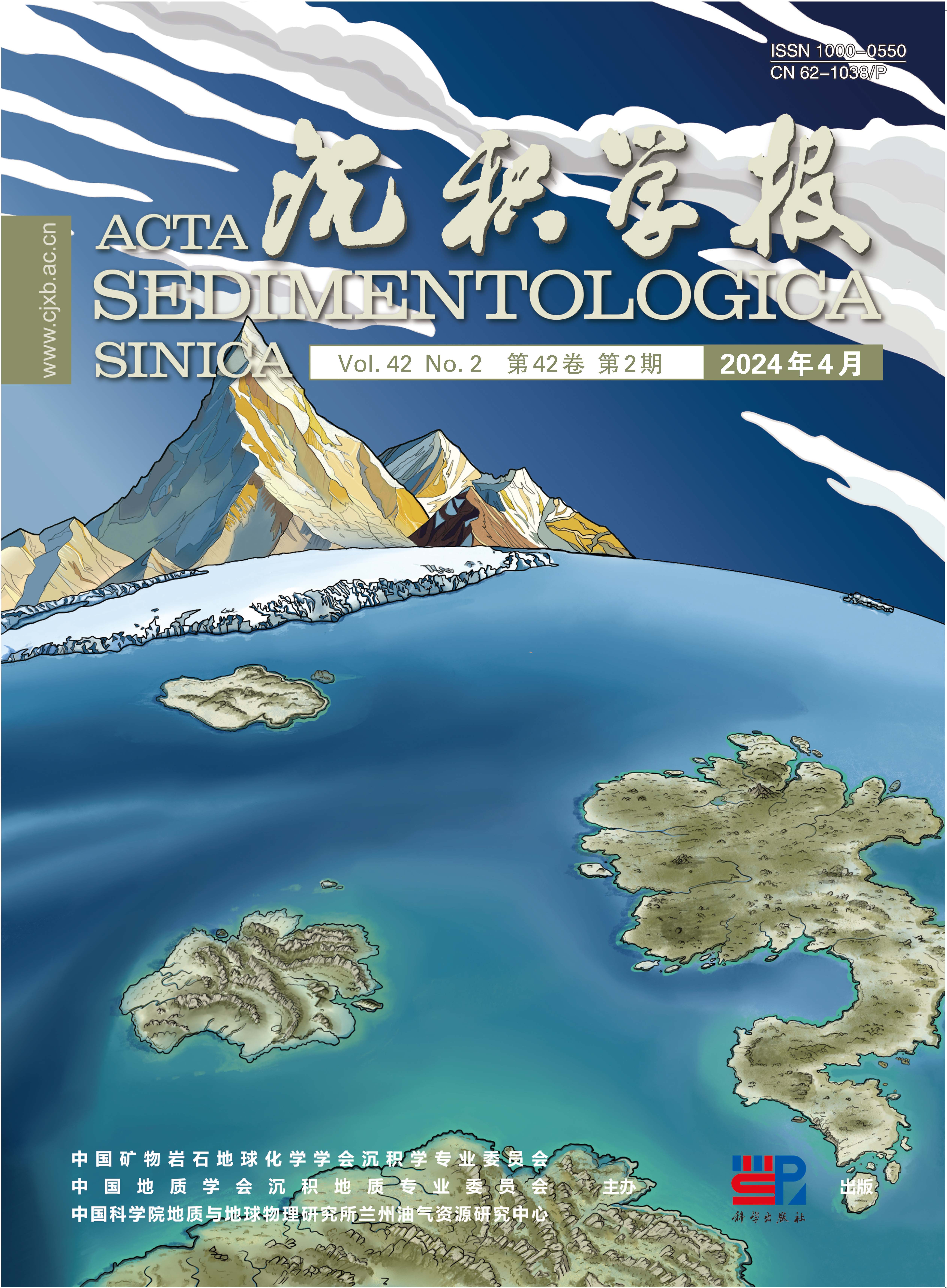


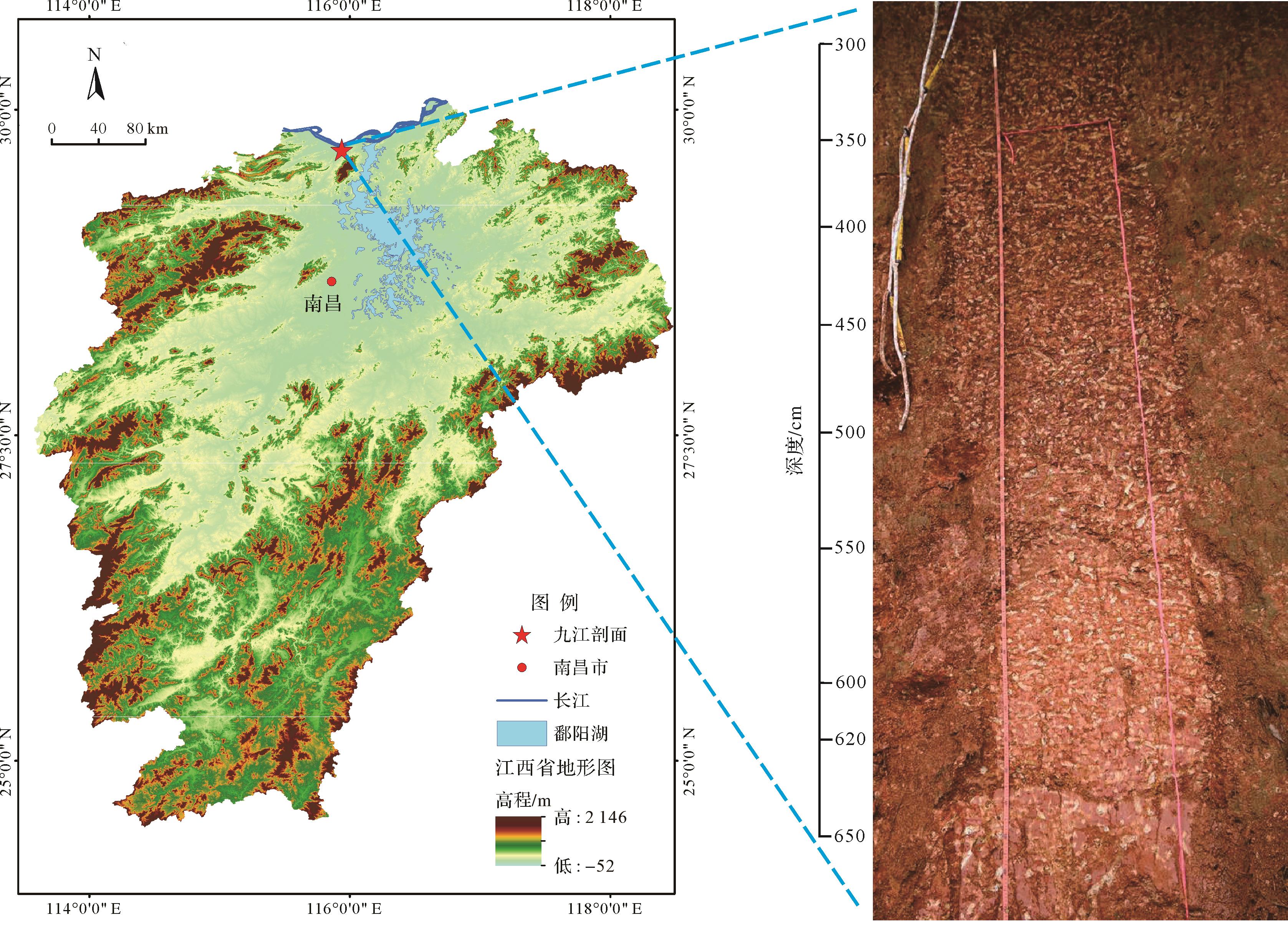











 DownLoad:
DownLoad:
